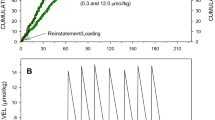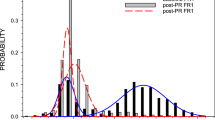Abstract
Intravenous cocaine self-administration behavior in rats was investigated using a progressive ratio (PR) schedule of reinforcement. The first response on the lever each day produced a drug infusion, whereupon the requirements of the schedule escalated with each reinforcement until the behavior extinguished. The final ratio completed each day was found to be relatively stable, sensitive to changes in dose, and drastically reduced by pretreatment with haloperidol (0.05 mg/kg). We conclude that self-administration behavior of rats reinforced on a progressive ratio schedule can provide useful information about changes in the reinforcing efficacy of specific drugs.
Similar content being viewed by others
References
Bedford JA, Bailey LP, Wilson MC (1978) Cocaine reinforced progressive ratio performance in the rhesus monkey. Pharmacol Biochem Behav 9:631–638.
Griffiths RR, Findley JD, Brady JV, Dolan-Gutcher K, Robinson WW (1975) Comparison of progressive-ratio performance maintained by cocaine, methylphenidate and secobarbital. Psychopharmacologia 43:81–83.
Griffiths RR, Brady JV, Snell JD (1978) Progressive-ratio performance maintained by drug infusions: comparison of cocaine, diethylpropion, chlorphentermine, and fenfluramine. Psychopharmacology 56:5–13.
Griffiths RR, Bradford LD, Brady JV (1979) Progressive ratio and fixed ratio schedules of cocaine-maintained responding in baboons. Psychopharmacology 65:125–136.
Hodos W (1961) Progressive ratio as a measure of reward strength. Science 134:943–944.
Hoffmeister F (1979) Progressive-ratio performance in the rhesus monkey maintained by opiate infusions. Psychopharmacology 62:181–186.
Johanson CE, Kandel DA, Bonese K (1976) The effects of perphenazine on self-administration behavior. Pharmacol Biochem Behav 4:427–433.
Koob GF, Vaccarino F, Amalric M, Bloom FE (1987) Positive reinforcement properties of drugs: search for neural substrates. In: Engel J, Oreland L (eds) Brain reward systems and abuse. Raven Press, New York, pp 35–50.
Rastogi SK, McMillan DE (1985) Effects of drugs on schedule-controlled behavior in rats during chronic haloperidol administration. J Pharmacol Exp Ther 232:295–300.
Risner ME, Cone EJ (1986) Intravenous self-administration of fencamfamine and cocaine by beagle dogs under fixed-ratio and progressive-ratio schedules of reinforcement. Drug Alcohol Depend 17:93–101.
Risner ME, Goldberg SR (1983) A comparison of nicotine and cocaine self-administration in the dog: fixed-ratio and progressive-ratio schedules of intravenous drug infusion. J Pharmacol Exp Ther 224:319–326.
Risner ME, Jones BE (1976) Role of noradrenergic and dopaminergic processes in amphetamine self-administration. Pharmacol Biochem Behav 5:477–482.
Risner ME, Jones BE (1976) Role of noradrenergic and dopaminergic processes in amphetamine self-administration, Pharmacol Biochem Behav 5:477–482.
Risner ME, Silcox DL (1981) Psychomotor self-administration by beagle dogs in a progressive-ratio paradigm. Psychopharmacology 75:25–30.
Roberts DCS (1988) Breaking points on a progressive ratio schedule reinforced by intravenous apomorphine increase daily following 6-hydroxydopamine lesions of the nucleus accumbens. Pharmacol Biochem Behav (in press)
Roberts DCS, Goeders N (1987) Drug self-administration: experimental methods and determinants. In: Boulton AA, Baker GB, Greenshaw AJ (eds) Neuromethods, vol 13. Humana Press, Clifton (in press)
Roberts DCS, Vickers G (1984) Atypical neuroleptics increase self-administration of cocaine: an evaluation of a behavioral screen for antipsychotic activity. Psychopharmacology 82:135–139.
Roberts DCS, Corcoran ME, Fibiger HC (1977) On the role of ascending catecholamine systems in intravenous self-administration of cocaine. Pharmacol Biochem Behav 6:615–620.
Roberts DCS, Klonoff P, Koob GF, Fibiger HC (1980) Extinction and recovery of cocaine self-administration following 6-hydroxydopamine lesions of the nucleus accumbens. Pharmacol Biochem Behav 12:781–787.
Roberts DCS, Bennett SAL, Vickers GJ (1989) Gender and estrous cycle affect cocaine self-administration on a progressive ratio schedule. Psychopharmacology, in press
Wilson MC, Schuster CR (1973) Cholinergic influence on intravenous cocaine self-administration by rhesus monkeys. Pharmacol Biochem Behav 1:643–649.
de Wit H, Wise RA (1977) Blockade of cocaine reinforcement in rats with the dopamine receptor blocker pimozide, but not the noradrenergic blockers phentolamine and phenoxybenzamine. Can J Psychol 31:195–203.
Yokel RA, Wise RA (1976) Attenuation of intravenous amphetamine reinforcement by central dopamine blockade in rats. Psychopharmacology 48:311–318.
Author information
Authors and Affiliations
Rights and permissions
About this article
Cite this article
Roberts, D.C.S., Loh, E.A. & Vickers, G. Self-administration of cocaine on a progressive ratio schedule in rats: dose-response relationship and effect of haloperidol pretreatment. Psychopharmacology 97, 535–538 (1989). https://doi.org/10.1007/BF00439560
Received:
Accepted:
Issue Date:
DOI: https://doi.org/10.1007/BF00439560




